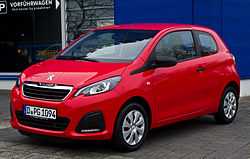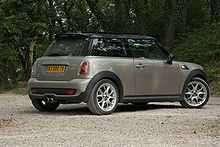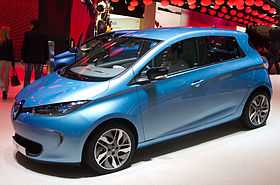A-segment

The A-segment is defined by the European Commission[1] as the first segment in the European market car classification (mini cars).
A proper definition does not exist, however the current European ranges of European manufactures is limited to approx. 3,700 millimetres (12 ft 2 in) in length. It corresponds to the City Car segment in British acceptation, and partially to the Subcompact Car segment in North America (although this segment also includes Supermini which are normally bigger, up to 4,300 millimetres (14 ft 1 in) length).
In 1992, the Renault Twingo I brought a revolution in the A-segment with its mono-volume shape, its happy design, its bright colours and interior pattern, and its digital speedometer. The Renault Twingo I lead the market till 2003.
European Market in 2015
The A-segment is a significant niche in Europe with a 10.7% market share in 2015.[2]
Since 2004, Fiat Group is the leader of the market with Fiat 500 (2007) and the Fiat Panda models, having 26% of the sales in 2015.
Volkswagen Group had a recent success with its new VW Up! which is the fourth best seller in European market. Together with its triplets Seat Mii and Skoda Citigo, the group is now at the 13% of the segment.
During recent years, the segment opened to premium cars with success, like the Mini and the Fiat 500. Opel entered the segment with a premium model, the Opel Adam, in the autumn of 2013.[3] Same approach has been taken by Renault with its totally re-designed Renault Twingo.
Joint ventures are present in the segment, in order for the manufacturers to save on development and production costs. PSA Peugeot Citroen and Toyota Group produced on the same platform the Citroen C1, the Peugeot 108 and the Toyota Aygo. Fiat Group produces on behalf of Ford the Ford Ka in its facility in Tychy (Poland). It is based on the same platform as the Fiat 500. In 2014 Renault and Daimler launched their jointly developed new generation Renault Twingo and Smart Fortwo/Forfour.
| Model | 2m sales 2015 |
|---|---|
| Fiat 500 | 27,168 |
| Fiat Panda | 26,720 |
| Renault Twingo | 17,518 |
| Volkswagen Up! | 17,506 |
| Mini | 15,553 |
| Toyota Aygo | 13,460 |
| Peugeot 108 | 12,347 |
| Hyundai i10 | 11,368 |
| Citroen C1 | 10,120 |
| Kia Picanto | 9,540 |
| Others | 48,933 |
Other models include:
| AutoVAZ | BMW Group | Chery | FCA Group | Ford Group | Geely Group | General Motors | Great Wall | Honda Group | Hyundai-Kia Group | Mazda Group | Mercedes Group |
|---|---|---|---|---|---|---|---|---|---|---|---|
| Ford Ka | Opel/Vauxhall Adam | Smart Fortwo | |||||||||
| Opel/Vauxhall Agila | |||||||||||
| Chevrolet Spark |
| Mitsubishi Group | PSA Group | Renault-Nissan Group | Ssangyong | Subaru | Suzuki | Tata Group | Toyota Group | VW Group |
|---|---|---|---|---|---|---|---|---|
| Mitsubishi Space Star/Mirage | Peugeot iOn | Renault Zoe | Suzuki Alto | Toyota iQ | Skoda Citigo | |||
| Mitsubishi i-MiEV | Peugeot 107 | Renault Twizy | Suzuki Celerio | Seat Mii | ||||
| Citroen C-Zero | Suzuki Splash |
In the United States

As the "segment" terminology became more common in the United States, the New York Times[4] described in 2012 the differences, saying "today’s small cars actually span three main segments in the global vehicle market".
The tiny A-segment cars (currently only 0.8% of US market [4] ) is dominated by European models Mini and Fiat 500. Segment includes the Smart Fortwo, the Scion iQ and the Chevy Spark. They’re extremely short and very light.
The A- and B-segment cars are known in the US as subcompacts.
| Model | 8 month sales 2012 |
|---|---|
| Mini | 30,289 |
| Fiat 500 | 28,566 |
| Smart Fortwo | 6,281 |
| Scion iQ | 6,189 |
| Chevrolet Spark | 4,090 |
| Mitsubishi i-MiEV | 403 |
See also
References
- ↑ "REGULATION (EEC) No 4064/89 - MERGER PROCEDURE". Office for Official Publications of the European Communities L-2985 Luxembourg.
- ↑ "European car sales analysis February 2015 – models". http://left-lane.com/.
- ↑ "Lightning-fast start for Opel ADAM: Over 20,000 orders and counting". Opel Media.
- ↑ 4.0 4.1 "Taking the ‘Cheap’ Out of the Small Car". The New York Times, September 9, 2012, Phil Patton.
